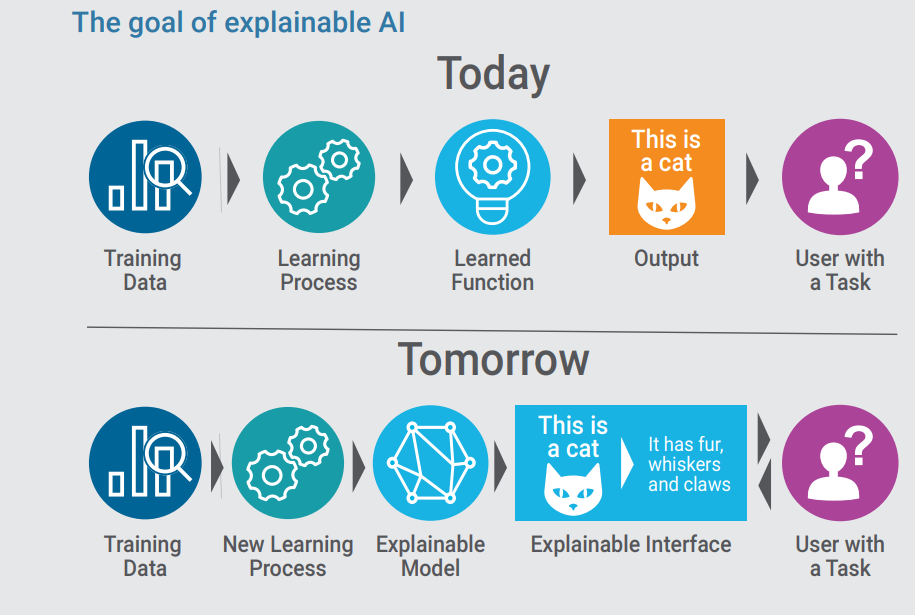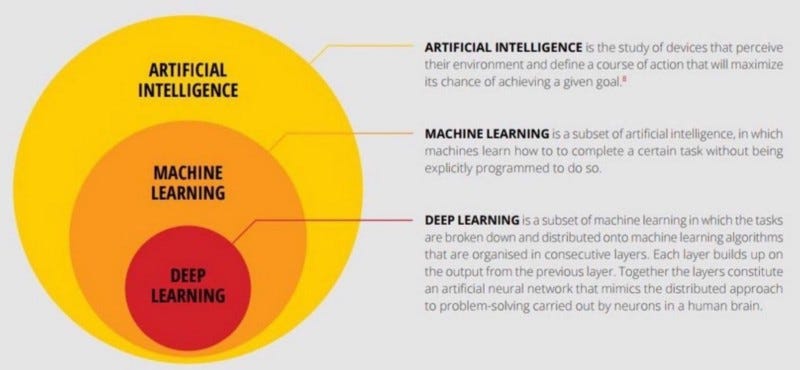Contents

(Source =https://www.datanami.com/2018/05/30/opening-up-black-boxes-with-explainable-ai/)
Need for Explainability in AI and Robotics
Introduction
Breakthroughs in Artificial Intelligence (AI) taken place during the last few years enabled possibilities for computers to perform tasks that would have been impossible to do using traditional software programming. These advancements are now opening up to us an entirely new world of potential applications for Artificial Intelligence such as Robotics, Finance and Medicine. Examples of modern AI applications can be: handwriting recognition, speech recognition, face recognition, computer vision etc…
Use of AI in decision-making applications (such as employment) has recently caused some concerns both for individuals and authorities. This is because, when working with deep neural networks, it is currently not possible (at least to a full extent) to understand the decision-making process the algorithm performs when having to carry out a predetermined task. Because of this lack of transparency in the decision-making process, perplexities can arise from the public regarding the trustworthiness of the model itself. Therefore, the need for Explainable AI is now becoming the next prefixed evolutionary step in order to prevent the presence of any form of bias in AI models.
Artificial Intelligence & Robotics
One of the main differences between traditional programming and AI is that non-AI programs are written defying a set of instructions. Instead, AI models learn without having to be explicitly programmed. This can, therefore, enable us to perform tasks that seemed impossible using traditional programming. Machine Learning (ML) is one of the most used AI tools. Some examples of how ML is currently used can be:
- Predictions while Commuting
- Videos Surveillance
- Email Spam and Malware Filtering
- Search Engine Result Refining
- Product Recommendations
- Online Fraud Detection
Machine Learning can potentially also be used to enhance industrial robotic systems abilities. As recent developments, particularly in Reinforcement Learning and Deep Learning, clearly show that there is a huge potential in this area.
There are two main types of robots. A traditional robot is a machine able to perform repetitive highly specialised tasks (eg.industrial robots). Instead, an intelligent robot is able to extract information from the surrounding environment in order to make meaningful decisions (eg. behaviour based robots).
There are four main areas in which Machine Learning can be applied in robotics [1]:
- Vision = detection and recognition of objects
- Grasping = determine best orientation and position to grasp objects
- Motion Control = obstacle avoidance and interaction
- Data = find patterns to decide the best action to take
Two examples of how Machine Learning can improve performance of robotics systems are Multi-Robots Systems and Swarms. This is because both these classes of robots mainly aim to perform complex tasks through collective behaviours. Programming collective behaviour using traditional programming can become an extremely challenging task, using Machine Learning (eg. Reinforcement Learning) instead can make it easier and possibly lead to more innovative solutions we couldn’t have thought of. The main differences between Multi-Robots systems and Swarms are that the former has global knowledge of the environment and can have a centralised architecture whilst the latter don’t have a global knowledge of the environment and use a decentralised architecture.
A sub-field of Machine Learning that can have really important applications in Robotics Systems is Deep Learning (DL). For example, DL algorithms using Multi-Layer Artificial Networks have managed to perform incredibly well in tasks such as image recognition which have really important applications in robotic systems vision. One problematic area though of DL algorithms is that currently, we are not able to fully track the decision making process the algorithm makes when having to make a decision (therefore the needs for Explainable AI).

Figure 1 — Relationship between AI-ML-DL (Image Reproduced from [2])
Ethics
The main aims of Explainable AI (XAI) is to make machines explain themselves and to reduce the impact of biased algorithms (Figure 2). One example of how ethics is becoming increasingly important in AI can be witnessed in the publication of a list of ethical principles Google is promising to follow when implementing AI algorithms [3]. Google decided to publish these principles to clarify in which areas the implementation of AI can become dangerous and to confirm its interest in producing AI self-explainable algorithms.

Figure 2 — Explainable AI Revolution (Image Reproduced from [4])
During the last few years, the first few XAI models have started being developed. Some of the most successful ones are: Reversed Time Attention Model (RETAIN), Local Interpretable Model-Agnostic Explanations (LIME) and Layer-wise Relevance Propagation (LRP) [5]. Theses listed methods used for producing explainable models are still nowadays not able to produce exhaustive results, therefore research in this area is still in need of further developments.
Bibliography
[1] Applying Artificial Intelligence and Machine Learning in Robotics, Robotic Industries Applications. (Accessed: https://www.robotics.org/blog-article.cfm/Applying-Artificial-Intelligence-and-Machine-Learning-in-Robotics/103) January 2019
[2] Deep learning series 1: Intro to deep learning — Dhanoop Karunakaran — Medium. (Accessed: https://medium.com/intro-to-artificial-intelligence/deep-learning-series-1-intro-to-deep-learning-abb1780ee20) January 2019
[3] Artificial Intelligence at Google — Our Principles — Google AI. (Accessed: https://ai.google/principles/) January 2019
[4] Explainable Artificial Intelligence (XAI) — Mr. David Gunning — DARPA.(Accessed: https://www.darpa.mil/program/explainable-artificial-intelligence) January 2019
[5] An introduction to explainable AI, and why we need it — Patrick Ferris — Medium. (Accessed: https://medium.freecodecamp.org/an-introduction-to-explainable-ai-and-why-we-need-it-a326417dd000) January 2019
Contacts
If you want to keep updated with my latest articles and projects follow me on Medium and subscribe to my mailing list. These are some of my contacts details:
